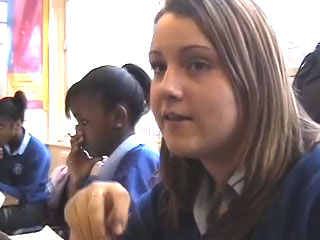



Literacy - Reading Comprehension
Utilizing Thinking Maps® to Promote Reading Comprehension and Motivation to Read in Urban Elementary School Males
By Patricia A. Edwards, Doctoral Candidate, Oakland University
Rochester, Michigan, 2011
The overall purpose of this mixed method research design was to examine whether teachers in a large urban Midwestern district used Thinking Maps® (Appendix A) with students in elementary school general education and special education classrooms. In addition, this study examined the use of Thinking Maps® with boys in three elementary classrooms: one-second grade, one fourth grade, and one classroom for the learning disabled. Students’ attitudes and comprehension toward reading with respect to the district’s core reading program and literature read-alouds was the focus. Utilizing Thinking Maps® yielded important information about strategies to promote reading comprehension and motivation to read in urban elementary school males.
![]() Download the dissertation Utilizing Thinking Maps® to Promote Reading Comprehension and Motivation to Read in Urban Elementary School Males (Acrobat PDF file)
Download the dissertation Utilizing Thinking Maps® to Promote Reading Comprehension and Motivation to Read in Urban Elementary School Males (Acrobat PDF file)
The Effect of Thinking Maps on Students’ Higher Order Thinking Skills
Laura A. Weis
California State University, Northridge, 2011
TIn Advanced Placement Environmental Science, students are required to demonstrate higher order thinking skills of analysis, synthesis, and evaluation. Thinking Maps are a specific series of graphic organizer’s produced by and educational consultant company and created by David Hyerle. Thinking Maps claim to increase students’ higher order thinking skills, but no peer-reviewed research has been completed on the success or usefulness of these graphic organizers. In order to determine the effect of Thinking Maps on students higher order thinking skills, student ability to compare and contrast and students essay scores were compared in essays given before and after Thinking Maps instruction. Students’ surveys were analyzed before and after Thinking Maps instruction on students’ use of Thinking Maps. Field notes were collected. After Thinking Maps instruction, students’ ability to compare and contrast increased by 69%; students’ essay scores increased by 16%. Both of these changes are statistically relevant. Student’s study habits and practices were surveyed before and after Thinking Maps instruction. Insignificant change in students reported study habits occurred before and after Thinking Maps instruction. Field notes were used to support these findings.
![]() Download the paper The Effect of Thinking Maps on Students’ Higher Order Thinking Skills (Acrobat PDF file)
Download the paper The Effect of Thinking Maps on Students’ Higher Order Thinking Skills (Acrobat PDF file)
An Examination of Student Performance after Two Years of Thinking Maps® Implementation in Three Tennessee Schools
By Katharine Mabie Hickie, May 2006
The purpose of this study was to determine what, if any, association exists between Thinking Maps® instruction and student achievement in fifth grade students in Reading/Language and Mathematics as reported by the State NCE scores of the criterion referenced portion of the Tennessee Comprehensive Assessment Program (TCAP) Achievement Test in 3 Title I elementary schools in northeast Tennessee.
Based on the analysis and findings of this study, implementing the Thinking Maps® program in the whole school approach appears to have been a successful step in improving student achievement in the area of Reading/Language.
![]() Download the dissertation An Examination of Student Performance after Two Years of Thinking Maps® (Acrobat PDF file)
Download the dissertation An Examination of Student Performance after Two Years of Thinking Maps® (Acrobat PDF file)
The Effects of Thinking Maps on Reading Scores 1998
Dissertation by Marjann Kalehoff Ball
Unpublished doctoral dissertation University of Southern Mississippi, 1999
Summary: A highly significant correlation was found between the use of Thinking Maps and reading comprehension scores of college students using the Stanford Diagnostic Reading Test.
![]() Download the summary of the dissertation The Effects of Thinking Maps on Reading Scores 1998 (Acrobat PDF file)
Download the summary of the dissertation The Effects of Thinking Maps on Reading Scores 1998 (Acrobat PDF file)
![]() Download the complete dissertation The Effects of Thinking Maps on Reading Scores 1998 (Acrobat PDF file)
Download the complete dissertation The Effects of Thinking Maps on Reading Scores 1998 (Acrobat PDF file)
![]() Read Marjann Ball's Reflections on her dissertation
Read Marjann Ball's Reflections on her dissertation
Integrating Content and Process
Chapter 6: Maps for the Road to Reading Comprehension: Bridging Reading Text Structures to Writing Prompts
Thomasina DePinto Piercy, Ph.D. and David Hyerle, Ed.D.
‘While I am reading, my mind adds to my Thinking Maps all by itself, and suddenly I know more than I knew’
First Grade Student
‘The discussion among Ms. Smith and her students is within reach of any school, replicable, and may refine and even reframe reading and writing instruction, and even offer a new direction for cognitive science research. This teacher had brought students to such a high level of fluency with thinking maps that they could begin to identify text patterns on their own. They were able to use fundamental thinking skills vocabulary (describing, compare, causes, etc.) and respective cognitive maps (bubble, double bubble, multi-flow, etc.) and had the metacognitive awareness of being able to explicitly transfer these processes and tools to reading comprehension through identifying text structures. They were then able to return to their seats with blank sheets of paper and, with varying results, choose a thinking map and expand their thinking. They later went on to write about the story using the maps they had chosen to organize their ideas.
![]() read more excerpts from chapter 6 and view the corresponding video clips
read more excerpts from chapter 6 and view the corresponding video clips
Improving Reading Compehension Through Visual Tools
Masters Degree Thesis by Cynthia Manning
Eastern Nazarene Graduate School, 2003
Summary: Reading comprehension in learning disabled students can be increased with the classroom implementation of visual tools. Student performance was measured using MCAS reading scores before and after the introduction of Thinking Maps, i.e., a set of visual tools which are centered on the development of eight thinking processes. By integrating this common visual language throughout the school's curriculum, it was projected that more effective and efficient learning would be achieved. Assessment results indicated that reading comprehension was increased; it was also observed by classroom teachers that levels of performance rose overall in the following areas: concept attainment, reflective thinking, recall, retention, writing (quantity and quality), creativity, motivation, and cooperative learning skills. These findings are congruent with a multitude of research studies and support the position that student performance can be increased with the implementation of visual tools.
![]() Case Study: read about and view video clips on Learning Prep
Case Study: read about and view video clips on Learning Prep
![]() Download the Master's Thesis summary Improving Reading Compehension Through Visual Tools (Acrobat PDF file)
Download the Master's Thesis summary Improving Reading Compehension Through Visual Tools (Acrobat PDF file)
![]() Download the Master's Thesis Improving Reading Compehension Through Visual Tools including student examples (Acrobat PDF file)
Download the Master's Thesis Improving Reading Compehension Through Visual Tools including student examples (Acrobat PDF file)
Thinking in Great Britain
 Visit a high school classroom in Great Britain including an interview with the Geography Teacher and two students. The teacher shares insights on thinking skills to “...put the notes into a form more conceptually understandable...”. The interview with the teacher is structured into purpose of use; comcept development; and their understanding. The two student interviews include reflections on tools of thinking including the observations of:
Visit a high school classroom in Great Britain including an interview with the Geography Teacher and two students. The teacher shares insights on thinking skills to “...put the notes into a form more conceptually understandable...”. The interview with the teacher is structured into purpose of use; comcept development; and their understanding. The two student interviews include reflections on tools of thinking including the observations of:
“That is brilliant”
“I'm able to think easier... makes things clearer in the mind...”
“...get more between the lines...”
![]() Go to and view the video clips of Thinking in Great Britain
Go to and view the video clips of Thinking in Great Britain
![]() Thinking Schools Network in Great Britain
Thinking Schools Network in Great Britain
The Effects of Thinking Maps on Reading Retention 1998
Masters Project by Melanie H. Blount
Catawba College, North Carolina, 2000
Summary: This results of this study indicate improvement in reading comprehension by underachieving 4th grade students in an inner city school.
![]() Download the Master's Thesis The Effects of Thinking Maps on Reading Retention (Acrobat PDF file)
Download the Master's Thesis The Effects of Thinking Maps on Reading Retention (Acrobat PDF file)
Implementing and Promoting Library Programs
Through Action Research
Marilyn Z. Joyce and Barbara Stein Martin
Presented at American Association of School Librarians conference, October, 2005
The research paper addresses the following questions:
- How does the use of “thinking maps” affect a student’s enjoyment of story time, which is a precursor of a student’s enjoyment of reading?
- Will students begin to determine by themselves which map(s) can be used to illustrate thinking about the story?
- To what degree do teachers (who are present during story time) show an interest in the maps and actually use them in their classrooms?
![]() Download the paper Implementing and Promoting Library Programs Through Action Research (Acrobat PDF file)
Download the paper Implementing and Promoting Library Programs Through Action Research (Acrobat PDF file)
Visual Thinking in Pre-K
 A Pre-K teacher at Bellevue Heights Nursery School in Syracuse, NY shares her students success with visual mapping as a group and their own work with mapping their ideas. She shares her insights, learning, and examples of the students thinking. A very dynamic teacher sharing some very exciting dynamics of the classroom.
A Pre-K teacher at Bellevue Heights Nursery School in Syracuse, NY shares her students success with visual mapping as a group and their own work with mapping their ideas. She shares her insights, learning, and examples of the students thinking. A very dynamic teacher sharing some very exciting dynamics of the classroom.
![]() Go to and view the video clips of Visual Thinking in Pre-K
Go to and view the video clips of Visual Thinking in Pre-K